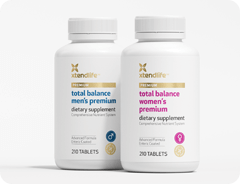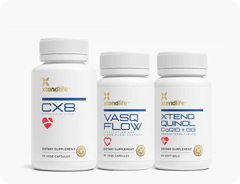What is pH?
pH stands for the power of hydrogen, which is a measurement of the hydrogen ion concentration in the body. The total pH scale ranges from 1 to 14, with 7 considered to be neutral. A pH less than 7 is said to be acidic and a pH greater than 7 is considered to be alkaline.
How does the body get acidic?
The human body is constantly creating acid as a by-product of metabolism. In addition, acid is introduced into the system through food. Our modern diet can be extremely acidic. Protein dense foods like meat, including beef, pork, chicken and turkey are acidic; as well as dairy products, protein powders, grains and drinks like coffee and soft drink.
While much of this acid is filtered by the kidneys and released from the body in urine (and perspiration), the body can only process a certain amount of acid at a time. That is why it is possible to ‘overload’ the system and for the body to become overly acidic.
Why does ‘body pH’ matter?
An overly acidic environment negatively affects our many bodily systems in many ways. You may not realize it, but many of the common health problems today can be attributed to slightly acidic bodily environments.
1. Circulatory System- Acidity is one of the primary causes of heart disease. This is because an internal acidic environment contributes to inflammation in the arteries, which in turn causes arteries to thicken with plaque, narrowing the blood flow and increases risk of heart disease.
2. Immune System- Acidic environments are breeding grounds for bad bacteria whereas the high levels of hydrogen rich body fluids keep bad bacteria inactive. Whether bad bacteria and pathogens incubate or remain dormant, often depends on the level of cellular pH.
2. Digestive System- Many digestive disorders, such as indigestion, nausea, bloating and gastric reflux, are symptoms caused by excess acid in the gastric region and not enough alkaline minerals in the intestinal tract.
4. Urinary System – The main organs of the urinary system are our kidneys which perform the task of filtering fluids and purifying our blood. If the body is overwhelmed by excess acids, the body copes with this by pulling alkaline minerals from your bones and depositing them in the blood. If this occurs frequently enough, the minerals build up in the kidneys in the form of painful kidney stones.
5. Muscular System- When acidity increases in the muscle cells, it disrupts the metabolism breakdown of glucose and oxygen to energy. This means muscles perform poorly in an acidic environment. An alkaline system on the other hand allows for much better aerobic metabolism and energy for the body's recovery from strenuous exercise.
How can I test my body pH?

I did a blog previously about testing your ‘pee-H’ (which you can read here), but you can also test your pH levels with your saliva. Saliva closely parallels the blood when it comes to pH levels, so all you need is some pH paper to find out if your body is overly acidic.
Step 1: Wait at least 2 hours after eating.
Step 2: Fill your mouth with saliva and swallow. Repeat to ensure your saliva is clean.
Step 3: Put some saliva onto the pH paper.
The color of the pH paper should turn blue. This indicates that your saliva is slightly alkaline at a healthy pH of 7.4. If it is not blue, compare the color with the chart that comes with the pH paper. If your levels are under 7.0 your body is slightly on the acidic-side.
Going Alkaline
We already ascertained that the body produces acidity through its own metabolic processes, and that a typical western diet adds to this load tremendously. The result is that the body creates fat cells to trap and neutralize these excess acids in the system. Some fat molecules can be excreted from the body, while others are stored, resulting in weight gain.
Going green is important because it gets a huge amount of chlorophyll into your body. Chlorophyll has the power to regenerate our bodies at a cellular level and is known to help cleanse the body, resist infection, help heal wounds, and promote the health of the circulatory, digestive, immune, and detoxification systems.
Chlorophyll consumption increases the number of red blood cells and, therefore, increases oxygen utilization by the body. It also helps to breaks down calcium oxalate stones for elimination, which are created by the body for the purpose of neutralizing and disposing of excess acid.
How much chorophyll do I need?
You would need a large amount of leafy greens daily. If you struggle with this, Zupafood GREENZ or Zupafood ELITE is the best answer. Save time and money juicing bunches of kale and spinach every morning. Zupafood GREENZ or Zupafood ELITE gives you a potent supply of green chlorophyll conveniently and easily.

The 30 Day Alkaline Challenge
30 days focusing on alkaline health starts here, with 1 being the most alkaline food group to 9 being the least. Don’t forget to test your pH at the beginning of your 30 day challenge and at the end of this to see the difference.
- Drinks:Zupafood GREENZ or Zupafood ELITE, water, herbal teas, lemon water
- Vegetables, Beans and Legumes: ALL leafy green vegetables (such as Spinach, Kale, Lettuce), Parsley, Avocado, Mushrooms, Broccoli, Cucumber, Zucchini, Asparagus, Garlic, Onion, Green Beans, Celery, Sweet Potato, Squash, Potato skins, Cabbage, Peas, Tomatoes, Corn, Carrot
- Fruits: Lemons, Limes, Watermelon, Grapefruit, Papayas, Mangoes, Kiwifruit, Melon
- Grains: Wild rice, Quinoa, Millet, Amaranth
- Nuts and Seeds: Almonds, Chestnuts
- Oils: Olive oil, Flax Seed oil
- Sweetener: Stevia, Maple Syrup, Raw Honey
- Meat: Venison, Fish, Turkey (occasionally)
- Dairy: Cut out all dairy if possible
In good health.


 Supplements
Supplements Bundles
Bundles









